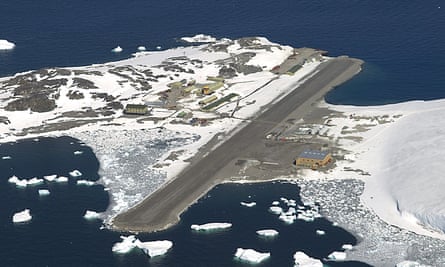A plane evacuating two workers in need of urgent medical treatment has successfully returned from a freezing and risky 3,000-mile midwinter round trip to a remote base at the south pole.
The Twin Otter aircraft – the only type of plane in the world capable of flying in the -60C (-76F) temperatures of the polar midwinter – began its return journey from the US science station at the pole to the British Rothera base on the Antarctic peninsula in the early hours of Wednesday morning. The flight took approximately 10 hours each way.
After a rest for the plane’s three-strong crew and a medical team member, the two patients were flown on to Punta Arenas, Chile, arriving at 9.41pm Eastern Daylight Time (EDT). From there, they will be taken to a medical facility at an undisclosed location.
The National Science Foundation (NSF), which runs the Amundsen-Scott south pole station, decided last week to mount the rescue mission because a staff member required urgent medical attention that could not be provided on the base. It later became apparent that the second worker also needed to be evacuated.“It went all according to plan,” said Peter West, a spokesman for the NSF. The agency would not identify the sick workers, who were employed by logistics contractor Lockheed Martin, or their conditions, citing medical privacy.
This is only the third midwinter emergency evacuation from the station. Workers there are otherwise isolated from February to October, when the cold and dark makes routine flights too perilous.

Weather readings showed the temperature at the south pole station on Tuesday was -60C (-76F). According to West, the Twin Otter can operate in conditions as cold as -75C (-103F). Before it takes off, the fuel, batteries and hydraulics need to be warmed.
Two Twin Otters – the second an emergency rescue back-up – are operated by the Canadian airline Kenn Borek and left Calgary, Canada, on 14 June.
After arriving at the Rothera base, one of the planes set out early on Tuesday to begin the 10-hour, 1,500-mile journey to the polar station. The other stayed at Rothera in case it was needed for search and rescue.Such a rescue flight is fraught with perils. “[Antarctica] is a landmass the size of the US and Mexico combined, so there is a distance issue,” West said. “And it’s cold – it is literally midwinter today. It’s very cold.”
This kind of midwinter rescue has been attempted only twice before: once in 2001, when the base’s only physician came down with a potentially fatal case of pancreatitis; and once in 2003. Both airlifts were successful.
In 1999, the station’s doctor, Jerri Nielsen, who had breast cancer and had been treating herself, was also flown out. However, this happened during spring, when conditions are slightly better.
The polar base is currently home to 39 men and nine women, engaged in various scientific and station maintenance endeavours, including long-term atmospheric carbon dioxide monitoring.
It has two radio telescopes which, according to the NSF, use cosmic microwave background radiation to investigate the early history of the universe, looking into dark energy and dark matter. It is also home to the Ice Cube Neutrino Observatory, which observes the behaviour of subatomic particles produced by black holes.

Comments (…)
Sign in or create your Guardian account to join the discussion